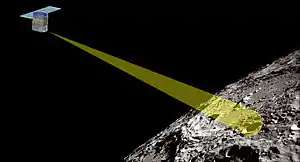LunIR
LunIR is a nanosatellite spacecraft launched to the Moon collecting surface spectroscopy and thermography. It was launched as a secondary payload on the Artemis 1 mission on 16 November 2022.[1][2]
 The LunIR CubeSat, which will characterize and collect lunar surface data. | |
| Names | SkyFire |
|---|---|
| Mission type | Technology demonstrator, reconnaissance |
| Operator | Lockheed Martin Space |
| COSPAR ID | 2022-156K |
| Mission duration | 11 months and 9 days (in progress) |
| Spacecraft properties | |
| Spacecraft | CubeSat |
| Spacecraft type | 6U CubeSat |
| Bus | Tyvak Nano-Satellite Systems |
| Manufacturer | Lockheed Martin Space |
| Launch mass | 14 kg (31 lb) |
| Dimensions | 10 cm × 20 cm × 30 cm |
| Start of mission | |
| Launch date | 16 November 2022, 06:47:44 UTC[1] |
| Rocket | SLS Block 1 |
| Launch site | KSC, LC-39B |
| Contractor | NASA |
| Flyby of Moon | |
Mission
LunIR is a technology demonstration mission funded by NASA that uses a low-cost 6U CubeSat spacecraft. LunIR will perform a lunar flyby, collecting spectroscopy and thermography for surface characterization, remote sensing, and site selection.[3] The spacecraft includes two deployable solar panels and will have a total mass of about 14 kg (31 lb).
LunIR was selected in April 2015 by NASA's NextSTEP program (Next Space Technologies for Exploration Partnerships) and awarded a contract to Lockheed Martin Space worth US$1.4 million for further development.[4][5][6]
LunIR will communicate with Earth via ground stations operated by Kongsberg Satellite Services. LunIR will use 13-meter-diameter radio antennas located in Punta Arenas, Chile; Svalbard, Norway; and Troll station, Antarctica.[7][8]
Launch
LunIR was launched as one of ten CubeSats as a secondary payload on the maiden flight of the Space Launch System, Artemis 1.[2]
Propulsion
LunIR will demonstrate a low thrust electric propulsion technology called electrospray propulsion to lower the spacecraft's orbit for additional science and technology mission objectives.[9]
See also
- Near-Earth Asteroid Scout by NASA was a solar sail spacecraft that was planned to encounter a near-Earth asteroid (mission failure)
- BioSentinel is an astrobiology mission
- LunIR by Lockheed Martin Space
- Lunar IceCube, by the Morehead State University
- CubeSat for Solar Particles (CuSP)
- Lunar Polar Hydrogen Mapper (LunaH-Map), designed by the Arizona State University
- EQUULEUS, submitted by JAXA and the University of Tokyo
- OMOTENASHI, submitted by JAXA, was a lunar lander (mission failure)
- ArgoMoon, designed by Argotec and coordinated by Italian Space Agency (ASI)
- Team Miles, by Fluid and Reason LLC, Tampa, Florida
- The three CubeSat missions removed from Artemis 1
- Lunar Flashlight will map exposed water ice on the Moon
- Cislunar Explorers, Cornell University, Ithaca, New York
- Earth Escape Explorer (CU-E3), University of Colorado Boulder
References
- Roulette, Joey; Gorman, Steve (16 November 2022). "NASA's next-generation Artemis mission heads to moon on debut test flight". Reuters. Retrieved 16 November 2022.
- Clark, Stephen (12 October 2021). "Adapter structure with 10 CubeSats installed on top of Artemis moon rocket". Spaceflight Now. Retrieved 22 October 2021.
- Williams, Greg; Crusan, Jason (April 2015). "Pioneering Space – Evolvable Mars Campaign" (PDF). NASA. Retrieved 9 March 2021.
 This article incorporates text from this source, which is in the public domain.
This article incorporates text from this source, which is in the public domain. - Morring, Frank (24 April 2015). "Habitats Could Be NASA's Next Commercial Spacecraft Buy". Aviation Week. Retrieved 26 May 2015.
- Clark, Stephen (8 April 2015). "NASA adding to list of CubeSats flying on first SLS mission". Spaceflight Now. Retrieved 9 March 2021.
- Krebs, Gunter (18 May 2020). "LunIR (SkyFire)". Gunter's Space Page. Retrieved 9 March 2021.
- "KSAT to support NASA LunIR mission". SpaceNews. 10 February 2022. Retrieved 14 February 2022.
- "KSAT to provide Ground Network support for the LunIR mission". www.ksat.no. Archived from the original on 14 February 2022. Retrieved 14 February 2022.
- "Next Space Technologies for Exploration Partnerships (NextSTEP) Projects". NASA. 5 May 2015. Retrieved 9 March 2021.
 This article incorporates text from this source, which is in the public domain.
This article incorporates text from this source, which is in the public domain.

